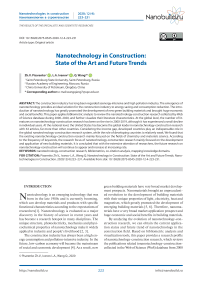Nanotechnology in Construction: State of the Art and Future Trends
Автор: Pisarenko Zh.V., Ivanov L.A., Wang Q.
Журнал: Nanotechnologies in Construction: A Scientific Internet-Journal @nanobuild-en
Рубрика: The results of the specialists’ and scientists’ researches
Статья в выпуске: 4 Vol.12, 2020 года.
Бесплатный доступ
The construction industry has long been regarded asenergy-intensive and high pollution industry. The emergence of nanotechnology provides an ideal solution for the construction industry to energy saving and consumption reduction. The introduction of nanotechnology has greatly promoted the development of new green building materials and brought huge economic and social benefits. This paper applies bibliometric analysis to review the nanotechnology-construction research collected by Web of Science database during 2000–2020, and further visualize their literature characteristics. At the global level, the number of literatures on nanotechnology-construction research has been on the rise in 2000-2019, although it has experienced a small decline in individual years. At the national level, the United States has become the global leader in nanotechnology-construction research with 63 articles, far more than other countries. Considering the income gap, developed countries play an indispensable role in the global nanotechnology-construction research system, while the role of developing countries is relatively weak. We found that the existing nanotechnology-construction research mainly focused on the fields of chemistry and materials science. According to the frequency of keywords, the research focus of nanotechnology-construction research mainly focused on the development and application of new building materials. It is concluded that with the extensive attention of researchers, the future research on nanotechnology-construction will continue to appear and increase at increasing rate.
Nanotechnology-construction research, bibliometrics, co-citation analysis, mapping knowledge domains
Короткий адрес: https://sciup.org/142226970
IDR: 142226970 | DOI: 10.15828/2075-8545-2020-12-4-223-231
Текст научной статьи Nanotechnology in Construction: State of the Art and Future Trends
N anotechnology is an emerging technology that was born in the late 1980s and is currently booming, which can develop materials and products with specific functional characteristics according to the expectations of researchers[1]. Nanotechnology is evaluated as a major discovery in the history of science in recent years and has become a research hotspot in many disciplines. The unique structure, photoelectricity, mechanics and physicochemical properties of nanotechnology make it widely applied in industry and people’s livelihood [2, 3].
The construction industry has always been a high energy consumption and pollution-intensive industry. In the future, low-carbon economy will become the mainstream of social and economic development [4]. As a result, new green building materials have very broad market development prospects. Nanomaterials brought an unprecedented revolution to the development of building materials with their unique properties of light, electricity, heat and magnetism, which greatly promoted the development of emerging building materials [5, 6]. Therefore, nanomaterials have a very broad market application prospect and huge economic and social benefits in building materials.
By analyzing the evolution of nanotechnology-construction research, we can obtain the current application status and future trend of nanotechnology in the construction field. Based on bibliometric analysis and visualization tools, this paper provides a research profile of nanotechnology-construction research, which reviews the publications related tonanotechnology-construction-collected in the Web of Science (WoS) database from 2000
THE RESULTS OF THE SPECIALISTS’ AND SCIENTISTS’ RESEARCHES to 2020 and their literature characteristics. Our results can identify the research hotspots of nanotechnology in the construction industry and provide theoretical support for further expanding the application of nanotechnology in the construction industry.
MAINPART
Materials and Methods
The data in this papercomes from the Web of Science Core Collection database of WOS database. WOS is the global authoritative, high-quality citation database, collecting a considerable number of publications from the fields of natural sciences, social sciences, arts and humanities, including books, journal articles, conference proceedings [7]. We searched with “TOPIC: (construction) AND TOPIC: (nanotechnology)” as the search type, and the time span was from 1900 to April 19, 2020. A total of 1204 records were obtained, including 705 articles, 9 editorial materials, 1 letter, 2 meeting abstracts, 3 news items, 164 procedures papers, and 320 reviews.
This paper uses bibliometric analysis based on data mining technology to investigate the current situation of the application of nanotechnology in the construction industry[8]. Furthermore, Mapping Knowledge Domains is adopted to visualize the hot topics and innovation areas in the existingnanotechnology-construction research. The method framework of this paper is shown in Fig. 1. Generally speaking, bibliometrics method contains three steps: identification, screening and analysis. In order to ensure the accuracy and validity of the data, the preliminary search results were deduplicated.
Bibliometric analysis allows us to systematically investigate the development of specific research field, and through quantitative and qualitative analysis of external features of the literature, such as author, keywords, citation, etc. [9]. This method can objectively evaluate the research status and development history of different countries, regions, scientific research institutions or authors in a specific field, so as to obtain information on the basic structure, frontier hotspots and development trends in the field. In addition, Citespace is used to complete the visual analysis of the data. Citespace software is a classic visualization tool that is widely used to present the structure, law and distribution of scientific knowledge [10]. Visual analysis providesMapping Knowledge Domains to help readers better understand the findings of this paper. The visualization software analyzes the cocitation of the literature, mines the knowledge clustering and distribution of the citation space [11]. Moreover,it provides the collinear analysis function between other knowledge units, such as the cooperation of authors, institutions, and countries.
Bibliometric analysis
This study comprehensively evaluates the development status and future trends of nanotechnology-construction research from four aspects: annual trend, cited authors, active countries and keywords.
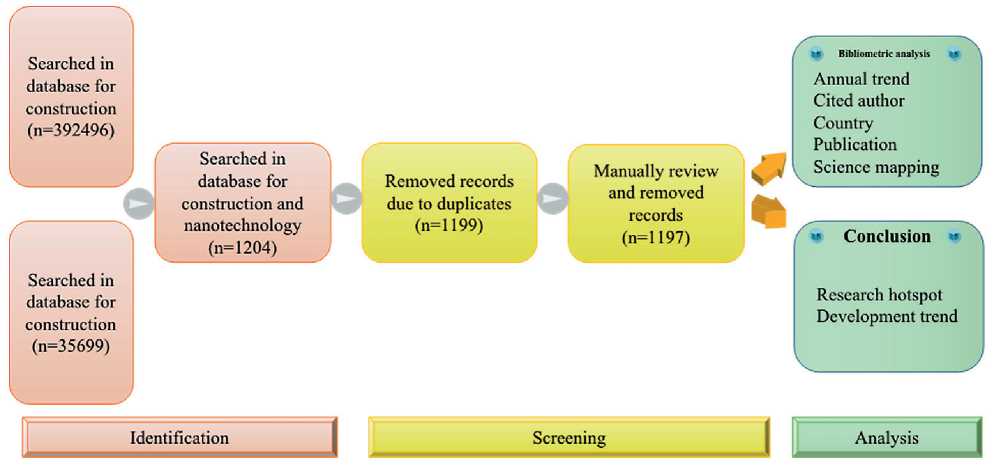
Fig.1. Steps of bibliometric analysis
THE RESULTS OF THE SPECIALISTS’ AND SCIENTISTS’ RESEARCHES
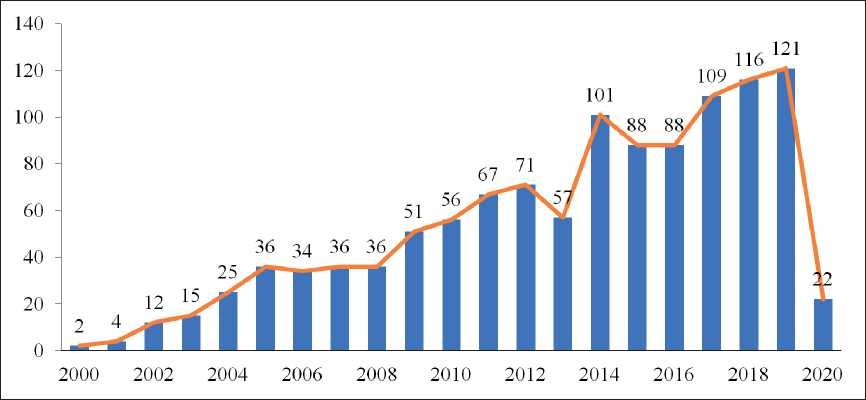
Fig. 2. Annual trend of nanotechnology-construction research 2000–2020
-
(i) Annual trend
Overall, the WOS database collected the first article related to nanotechnology-construction in 2000, marking the beginning of the application of nanotechnology in the construction industry (Fig. 2). From 2000 to 2019, the number of articles in this field has been showing an upward trend, indicating that the application of nanotechnology in the construction industry aroused the interest of scholars. It should be noted that due to incomplete statistics in 2020, it has no reference significance. With the passage of time, the popularity of nanotechnologyconstruction research continues to rise, attracting growing
number of researchers to pay attention to the innovative application of nanotechnology in the construction field.
Focusing on individual years, nanotechnologyconstruction research grew slowly during 2000–2012, indicating that the application of nanotechnology in the construction field is still at an early stage and its development is relatively slow. In 2013, nanotechnology-construction research experienced a significant drop, from 71 in 2012 to 57 in 2013. Subsequently, nanotechnologyconstruction research rebounded in 2014, an increase of 68.12%. After 2014, nanotechnology-construction research once again declined slightly, but overall it keeps increasing year by year.
|
338 CHEMISTRY MULTIDISCIPLINARY |
153 CHEMISTRY PHYSICAL |
63 ENGINEERING ELECTRICAL ELECTRONIC |
51 CHEMISTRY ANALYTICAL |
43 PH/ PH/ |
^RMACOLO< ^RMACY |
3Y |
41 MULTII SCIENI |
DISCIPLIN CES |
|
|
314 MATERIALS SCIENCE MULTIDISCIPLINARY |
140 PHYSICS APPLIED |
DZ ENGINEERING CIVIL |
39 POLYMER SCIENCE |
25 OPTICS |
2 El |
4 LECTRO |
24 ENGINE! BIOMED |
||
|
94 |
58 CONSTRUCTION BUILDING |
34 BIOPHYSICS |
|||||||
|
BIOCHEMISTRY MOLECULAR BIOLOGY |
TECHNOLOGY |
24 |
1 |
[22 |
1 |
||||
|
281 NANOSCIENCE NANOTECHNOLOGY |
78 PHYSICS CONDENSED MATTER |
53 BIOTECHNOLOGY APPLIED MICROBIOLOGY |
29 INSTRUMENTS IMCTOI1МРМТДТ1ПМ |
MEDICINE RESEARCH EXPERIMENTAL |
MATERIALS SCIENCE BIOMATERIA1 |
||||
|
27 BIOCHEMICAL RESEARCI METHODS |
23 CHEMISTRY MEDICINAL |
21 COMPUTER SCIENCE INTERDISCIP APPLICATION* |
|||||||
Fig. 3. The proportion of cases distributed by category
THE RESULTS OF THE SPECIALISTS’ AND SCIENTISTS’ RESEARCHES
In short, during the period 2000–2019, nanotechnology-construction research showed an increasing trend, although individual years experienced a small decline. If according to the current development trend, nanotechnology-construction research will continue to rise in the future. The emergence of nanotechnology has greatly improved traditional building materials, not only improving the performance of building materials, but also reducing environmental pollution. In this sense, nanotechnology-construction research will usher in a period of rapid growth.
-
(ii) Hot topics
Fig. 3 shows the categories of disciplines involved in existing nanotechnology-construction research. Nanotechnology-construction research involves 25 disciplines. Among the top 5 are chemistry multidisciplinary (338 articles), materials science multidisciplinary (314 articles), nanoscience nanotechnology (281 articles), chemistry physical (153 articles), physics applied (140 articles). The above data indicates that nanotechnology-construction research is mainly concentrated in the fields of chemistry and materials science. The application of nanotechnology to improve traditional building materials is one of the main applications of nanotechnology in the construction industry. For example, nanotechnology can greatly improve the antibacterial and antifouling performance, aging resistance, hydrophilicity, and fire resistance of architectural coatings [12, 13]. New concrete developed using nanotechnology can significantly improve the strength and construction performance of cement concrete [14, 15].
In addition, nanotechnology-construction research also appeared in biochemistry molecular biology, physics condensed matter, engineering electrical electronic, optics, pharmacology pharmacy and other fields, which means that nanotechnology has become a common concern of many disciplines, and a lot of research is being carried out from different perspectives. The search results are in line with the development status of nanotechnology. In fact, nanotechnology is a highly cross-cutting comprehensive technology, covering many disciplines such as nanophysics, Nano chemistry, nanomaterials, Nano mechanics, nanobiology and so on. Because of this, nanotechnology is widely used in construction materials,
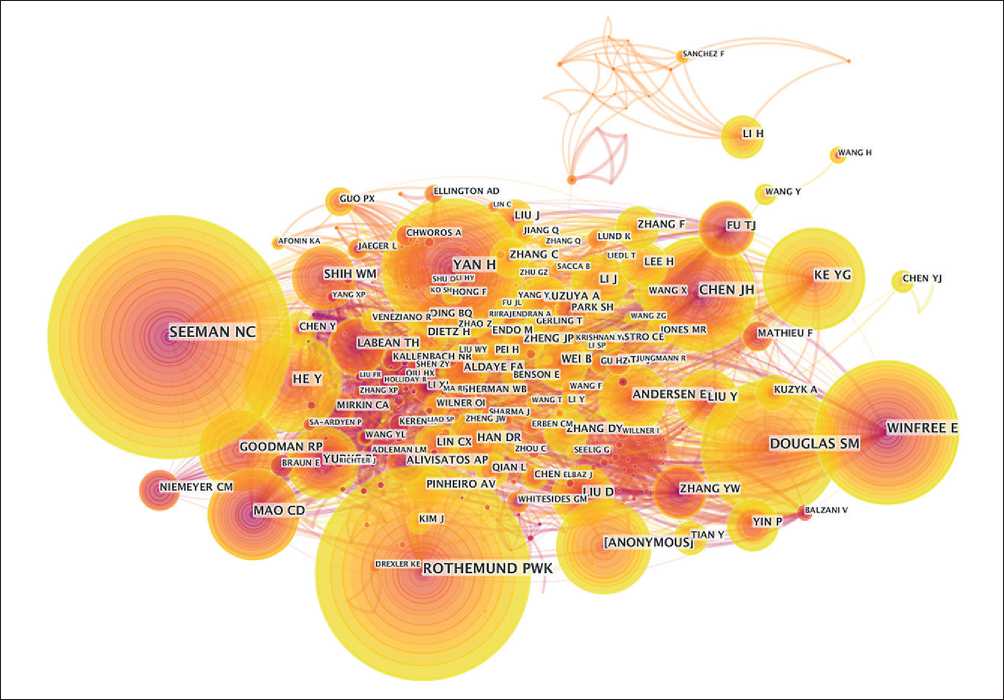
Fig. 4. The cooperation network of cited author
THE RESULTS OF THE SPECIALISTS’ AND SCIENTISTS’ RESEARCHES
Table 1
The count of papers published by author
-
(iii) Cited Authors
Co-citation analysis means that two articles appear together in the reference list of the third article, which we call co-citation relationship. In this section, we conduct Author Co-Citation analysis on the basis of Journal Cocitation Analysis. The Author Co-Citation analysis can not only obtain high-cited authors in a certain field and identify influential scholars in this field, but also can understand the authors and their subjects of similar research topics in this field through the author co-citation network. Fig. 4 visualizes the results of the co-citation analysis.
As shown in Fig. 4, the area of concentric circles represents the author’s central position. From purple, red, orange, and yellow, it means that the document time advances in turn. The observed data indicates that 549 authors participated in the nanotechnology-construction study and there are 3250 co-cited relationships among them. The dense connection in Fig. 4 shows that the cooperation between the authors of nanotechnologyconstruction research is relatively close, which is condu- cive to promoting innovation and forward development in this field. Furthermore, the cooperation of the authors has increased over time, indicating that researchers in nanotechnology-construction research have strengthened their cooperation and are forming a stable cooperative network.
Table 1 lists the top 10 authors by volume, including their total citations and main research directions. From the data in Table 1, the main research directions of these highly cited authors are concentrated in the field of Biochemistry Molecular Biology. In addition, Materials Science, Genetics Heredity and Engineering are also their main subjects. Nanotechnology is to study the properties and applications of substances at the molecular and atomic level (between 0.1–100 nm). Therefore, many scholars conducting research on nanotechnology-construction are gathered in these fields.
-
(iv) Countries
Fig. 5 depicts the path of cooperation between countries in nanotechnology-construction research system. The area of the circle depends on the number of publications. From Fig.5, the United States is the global leader in nanotechnology-construction research, because it has the most publications with 63 articles. China ranked second, followed by Germany, Japan and the United Kingdom. As far as the country is concerned,
THE RESULTS OF THE SPECIALISTS’ AND SCIENTISTS’ RESEARCHES
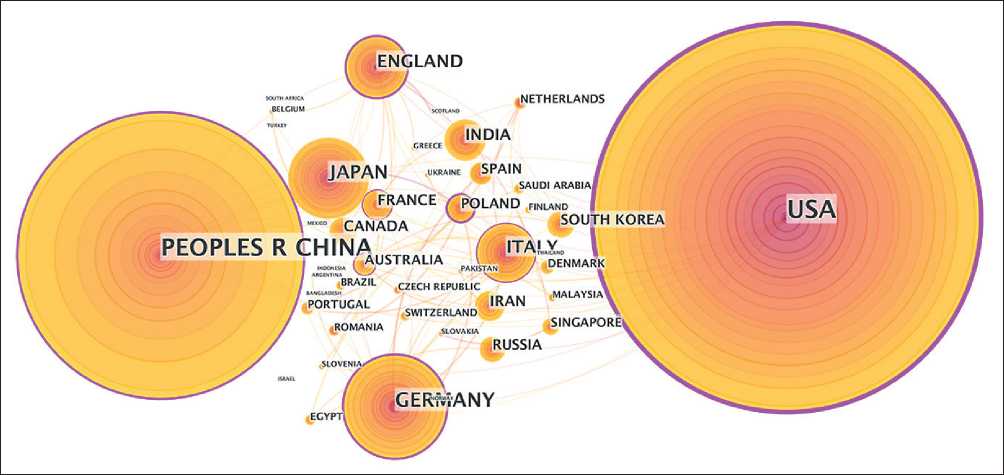
Fig. 5. National cooperation network
Table 2
Number of papers in countries
-
(v) Keywords
Fig. 6 summarizes the keywords that appear in nanotechnology-construction research according to the time point of first occurrence. Keywords often condense the central idea and research methods of an article. It can help us quickly grasp the core content of an article, and then understand the cutting-edge research direction in a specific field. Table 3 lists the top 10 high frequency keywords and their frequency.
The higher the frequency of keywords, the more intensive the research. Due to the numerous disciplines
THE RESULTS OF THE SPECIALISTS’ AND SCIENTISTS’ RESEARCHES
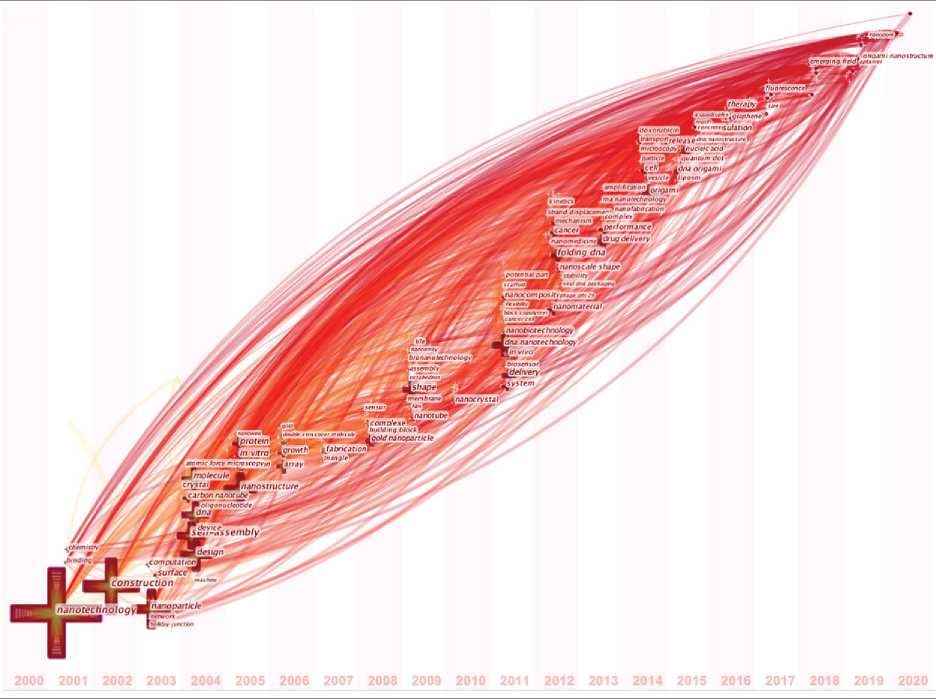
Fig. 6. Keywords in nanotechnology-construction research
Table 3
Top 10 high frequency keyword
It should be noted that materials published on the Internet in free access, for example, in the journal «Nano- technologies in construction» [18-21] and others are of great interest to scientists and specialists of the nanoin-dustry.Articles from the journal (article metadata) are available in open access:
-
• on the website of the electronic publication «Nanotech-nology in construction: scientific online magazine», link – http://nanobuild.ru/en_EN/archieve-of-issues/ ;
-
• in the full-text database of open-access scientific journals Open Academic Journals Index (OAJI), link – http://oaji.net/journal-detail.html?number=6931 ;
THE RESULTS OF THE SPECIALISTS’ AND SCIENTISTS’ RESEARCHES
-
• on the website of the scientific electronic library, link – http://elibrary.ru/contents.asp?issueid=1568760 ;
-
• in the database of scientific journals Directory of Open Access Journals (DOAJ), link – https://doaj . org/, next – thejournal is searched «Nanotehnologii v Stroitel’stve»;
-
• in the database of scientific journals ResearchBib, link – http://journalseeker.researchbib.com/view/ issn/2075-8545;
-
• on the Internet resource of scientists of all scientific disciplines ResearchGate, link – https://www.re-searchgate.net/journal/2075-8545_Nanotechnolo-gies_in_Construction ;
-
• in the international scientific base Readera – https:// readera.ru/nanobuild;
-
• in other citation systems (databases).
That allows scientists and specialists all over the world to study journal’s materials and to use them in their work as well as to cite them.
CONCLUSIONS
In this paper, we use bibliometric analysis to review the literatures related to nanotechnology-construction recorded in the WOS database from 2000 to 2020 (the statistics in 2020 are not complete yet). Moreover, this paper visualized the literature characteristics of these studies from four aspects: annual change, hot topics, distribution countries and keywords, in order to fully understand the development status and future trend of nanotechnology-construction research. The main findings of this paper are as follows:
Globally, the number of literatures on nanotechnology construction research has been on the rise in 2000–2019, although it has experienced a small decline in individu- alyears. It is concluded that with the extensive attention of researchers, the future research on nanotechnology-construction will continue to emerge and accelerate the growth. Besides, existing nanotechnology-construction research mainly focuses on the fields of chemistry and materials science. It shows that the application of nanotechnology to improve the traditional building materials is still the main application of nanotechnology in the construction industry. The results of co-citation analysis indicate that the high-yield authors of nanotechnology-construction research focus on the field of biological molecular biology. At the national level, the United States has become the global leader in nanotechnology-construction research with 63 articles, far more than other countries. Considering the income gap, developed countries play an indispensable role in the global nanotechnology construction research system, while the role of underdeveloped countries or regions is relatively weak. According to the frequency of keywords, we found that the existing nanotechnology-construction researchis mainly concentrated on the development and application of new building materials.
To sum up, the application of nanotechnology in the construction industry has gone through the stage of theoretical exploration and gradually turned to practical application. In this context, the future global nanotechnology-construction research will accelerate and continue to expand the application scope of nanotechnology in building materials. Developed countries play an important role in the global nanotechnology-construction research system. As the fastest growing economy in the world, China ranks the second in the world in nanotechnologyconstruction research. It suggests that developing countries are also striving to accelerate the deep integration of nanotechnology and construction industry.
Список литературы Nanotechnology in Construction: State of the Art and Future Trends
- Lazaro A., Yu Q.L.,Brouwers H.J.H. 4 – Nanotechnologies for sustainable construction. Sustainability of Construction Materials (Second Edition). Woodhead Publishing; 2016.
- Jones W., et al.Nanomaterials in construction – what is being used, and where? In: Proceedings of the Institution of Civil Engineers – Construction Materials. 2019.172 (2): p. 49–62. Available from: doi: 10.1680/jcoma.16.00011.
- Al-Bayati Ahmed, J. and A. Al-Zubaidi Hazim. Inventory of Nanomaterials in Construction Products for Safety and Health. Journal of Construction Engineering and Management. 2018; 144(9). Available from: doi:10.1061/(ASCE) CO.1943-7862.0001547.
- Zhu W., et al. Functionalization of hollow nanomaterials for catalytic applications: nanoreactor construction. Advanced Materials. 2019; 31(38): 1800426. Available from: https://onlinelibrary.wiley.com/doi/full/10.1002/adma.201800426 [Accessed 14th August 2020]
- Contreras J.E., Rodriguez E.A., and Taha-Tijerina J. Nanotechnology applications for electrical transformers – A review.Electric Power Systems Research. 2017; 143:573-584. Available from: doi: 10.1016/j.epsr.2016.10.058.
- West G.H., et al.Toward responsible development and effective risk management of nano-enabled products in the U.S. construction industry. Journal of Nanoparticle Research. 2016;18 (2): 49. Available from: doi: 10.1007/s11051-016-3352-y.
- Mongeon P., Paul-Hus A.The journal coverage of Web of Science and Scopus: a comparative analysis. Scientometrics. 2016;106(1):213-228. Available from: doi: 10.1007/s11192-015-1765-5.
- Yang D., et al.History and trends in solar irradiance and PV power forecasting: A preliminary assessment and review using text mining.Solar Energy. 2018;168:60-101. Available from: doi: 10.1016/j.solener.2017.11.023.
- Wang J., VeugelersR., StephanP. Bias against novelty in science: A cautionary tale for users of bibliometric indicators. Research Policy. 2017;46(8):1416-1436. Available from: doi:10.1016/j.respol.2017.06.006.
- Laengle S., et al.Forty years of the European Journal of Operational Research: A bibliometric overview.European Journal of Operational Research. 2017; 262(3):803-816. Available from: doi: 10.1016/j.ejor.2017.04.027.
- Geng S., et al.Building life cycle assessment research: A review by bibliometric analysis.Renewable and Sustainable Energy Reviews. 2017;76:176-184. Available from: doi: 10.1016/j.rser.2017.03.068.
- Zheng L., Xiong T., Shah K.W. Transparent nanomaterial-based solar cool coatings: Synthesis, morphologies and applications. Solar Energy. 2019;193:837-858. Available from: doi: 10.1016/j.solener.2019.10.029.
- Dahlan A.S. Smart and Functional Materials Based Nanomaterials in Construction Styles in Nano-Architecture. Silicon. 2019;11(4):1949-1953. Available from: doi: 10.1007/s12633-018-0015-x.
- Wu Z., et al.Effects of different nanomaterials on hardening and performance of ultra-high strength concrete (UHSC). Cement and Concrete Composites. 2016;70:24-34. Available from: doi: 10.1016/j.cemconcomp.2016.03.003.
- Diab A.M., et al.Effect of nanomaterials additives on performance of concrete resistance against magnesium sulfate and acids. Construction and Building Materials. 2019;210: 210-231. Available from: doi: 10.1016/j.conbuildmat.2019.03.099.
- Bossa N., et al.Environmental exposure to TiO2 nanomaterials incorporated in building material. Environmental Pollution. 2017; 220: 1160-1170. Available from: doi: 10.1016/j.envpol.2016.11.019.
- Sierra-Fernandez A., et al.New nanomaterials for applications in conservation and restoration of stony materials: A review.Materiales de Construccion. 2017; 67(325): 107.
- Ivanov L.A., Razumeev K.E., Bokova E.S., Muminova S.R. The inventions in nanotechnologies as practical solutions. Part V. Nanotechnologies in Construction. 2019;11(6): 719–729. Available from: doi: 10.15828/2075-8545-2019-11-6-719-729.
- Ivanov L.A., Bokova E.S., Muminova S.R., Katuhin L.F. Nanotechnologies: a review of inventions and utility models. Part I. Nanotechnologiesin Construction. 2020;12(1):27–33. Available from: doi: 10.15828/2075-8545-2020-12-1-27-33.
- Ivanov L.A., Kapustin I.A., Borisova O.N., Pisarenko Zh.V. Nanotechnologies: a review of inventions and utility models. Part II. Nanotechnologiesin Construction. 2020; 12(2): 71–76. Available from: doi: 10.15828/2075-8545-2020-12-2-71-76.
- Ivanov L.A., Demenev A.V., Pisarenko Zh.V., Wang Q. Nanotechnologies: a review of inventions and utility models. Part III. Nanotechnologiesin Construction. 2020;12(3): 140–146. Available from: doi: 10.15828/2075-8545-2020-12-3-140-146.

